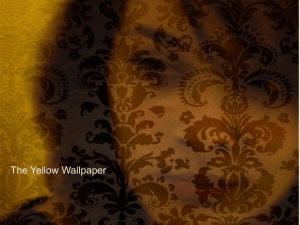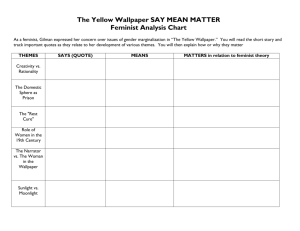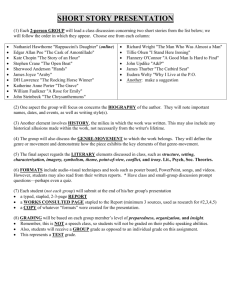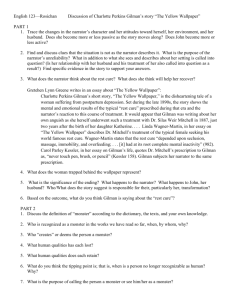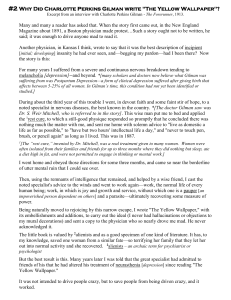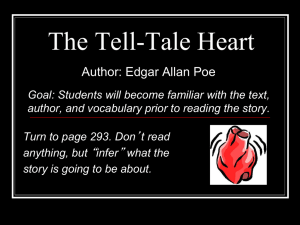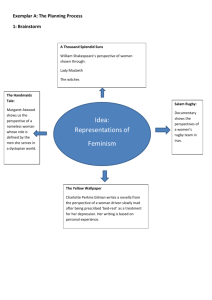Short Story Analysis Essay Prompts - English 1B
advertisement
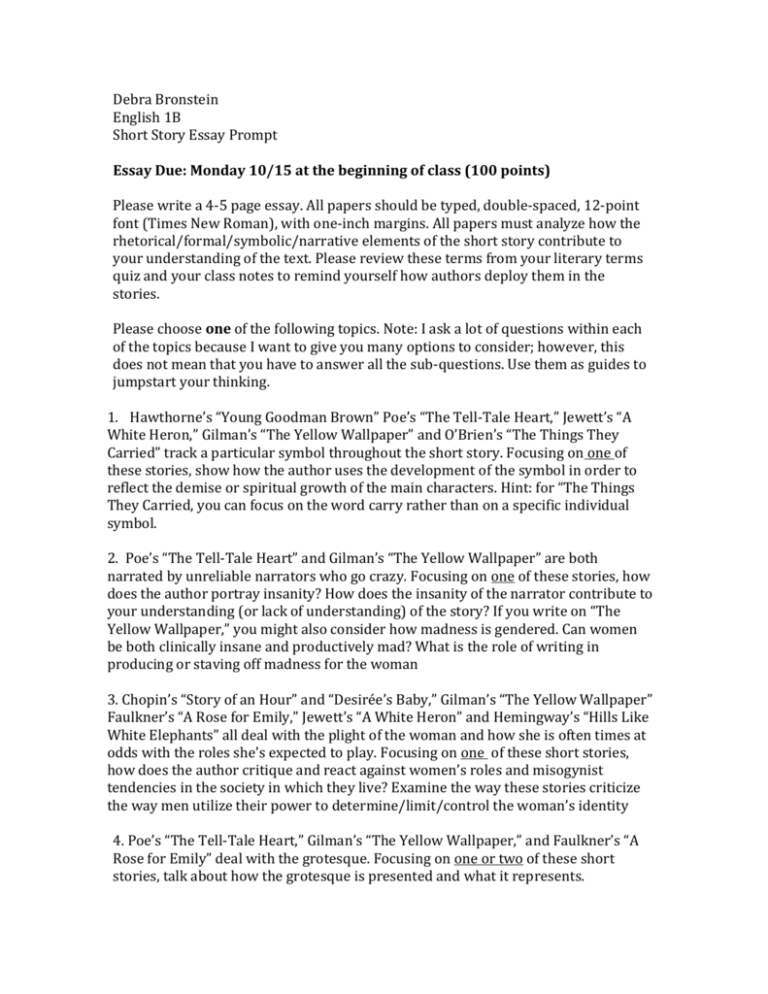
Debra Bronstein English 1B Short Story Essay Prompt Essay Due: Monday 10/15 at the beginning of class (100 points) Please write a 4-5 page essay. All papers should be typed, double-spaced, 12-point font (Times New Roman), with one-inch margins. All papers must analyze how the rhetorical/formal/symbolic/narrative elements of the short story contribute to your understanding of the text. Please review these terms from your literary terms quiz and your class notes to remind yourself how authors deploy them in the stories. Please choose one of the following topics. Note: I ask a lot of questions within each of the topics because I want to give you many options to consider; however, this does not mean that you have to answer all the sub-questions. Use them as guides to jumpstart your thinking. 1. Hawthorne’s “Young Goodman Brown” Poe’s “The Tell-Tale Heart,” Jewett’s “A White Heron,” Gilman’s “The Yellow Wallpaper” and O’Brien’s “The Things They Carried” track a particular symbol throughout the short story. Focusing on one of these stories, show how the author uses the development of the symbol in order to reflect the demise or spiritual growth of the main characters. Hint: for “The Things They Carried, you can focus on the word carry rather than on a specific individual symbol. 2. Poe’s “The Tell-Tale Heart” and Gilman’s “The Yellow Wallpaper” are both narrated by unreliable narrators who go crazy. Focusing on one of these stories, how does the author portray insanity? How does the insanity of the narrator contribute to your understanding (or lack of understanding) of the story? If you write on “The Yellow Wallpaper,” you might also consider how madness is gendered. Can women be both clinically insane and productively mad? What is the role of writing in producing or staving off madness for the woman 3. Chopin’s “Story of an Hour” and “Desirée’s Baby,” Gilman’s “The Yellow Wallpaper” Faulkner’s “A Rose for Emily,” Jewett’s “A White Heron” and Hemingway’s “Hills Like White Elephants” all deal with the plight of the woman and how she is often times at odds with the roles she’s expected to play. Focusing on one of these short stories, how does the author critique and react against women’s roles and misogynist tendencies in the society in which they live? Examine the way these stories criticize the way men utilize their power to determine/limit/control the woman’s identity 4. Poe’s “The Tell-Tale Heart,” Gilman’s “The Yellow Wallpaper,” and Faulkner’s “A Rose for Emily” deal with the grotesque. Focusing on one or two of these short stories, talk about how the grotesque is presented and what it represents. 5. O’Connor’s short story “A Good Man is Hard to Find” and Faulkner’s “A Rose for Emily” can be classified as Southern Gothic. Focusing on one of the short stories, write an essay in which you show how O’Connor or Faulkner explores the relationship between the Old South, Middle South and New South. Is the New South victorious precisely because it is new and modern, or does the author present a nostalgic view of the Old South in order to comment on the need to preserve heritage? Or, is neither version of the South promoted? What happens to those who fall somewhere in the middle of the Old South and New South? How does morality function in these stories: is there a moral to the story? In order to answer these questions, you will need to focus on one of the following themes in your chosen story/stories. Religion/faith/salvation and the hypocrisy of the people who follow religion. Look closely at the contrast between the Christianity of the Old South, the use of the Bible for the character’s own purposes in the Middle South and the atheistic tendencies of the New South. Instability of the word “Good” The ostracized individual who is oppressed by traditional Southern culture The hypocrisy of the women in the Old South The grotesque and what it says about the South . 6. Chopin’s “Desirée’s Baby” and “The Story of an Hour,” Poe’s “The Tell-Tale Heart” Gilman’s “The Yellow Wallpaper,” O’Connor’s “Good Country People” and Baldwin’s “Sonny’s Blues” all focus on the way in which the body is represented as unhealthy, ill, addicted or deformed. Focusing on one of these short stories, write an essay examining the role that illness or addiction plays in determining character identity. How do other people try to control the character’s illness? How does the character’s illness affect other characters in the short story. 7. Hawthorne’s “Young Goodman Brown” and O’Connor’s “A Good Man is Hard to Find” examine the role of religion/faith/salvation in society and present the hypocrisy of the people who follow religion. Focusing on one of these short stories, show how the author uses religion as a vehicle to explore character development or to reveal society’s emphasis on religion as hypocritical, outdated, or unnecessary. 8. Chopin’s “Desirée’s Baby,” James Baldwin’s “Sonny’s Blues” Ellison’s “Battle Royal” and Bambara’s “The Lesson” all deal with racial identity arising from racial tensions. Choose one of the short stories and show how the author uses a specific character or a specific situation in order to examine how race is understood.


